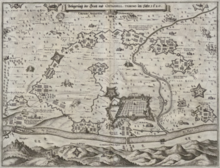Siege of Turin (1640)
| Siege of Turin(1640) | |||||||
|---|---|---|---|---|---|---|---|
| Part of thePiedmontese Civil War | |||||||
 Siege of Turin’s Citadel (engraving by M. Merian/C. Cappi) | |||||||
| |||||||
| Belligerents | |||||||
|
Kingdom of France Regency faction |
Spain Prince Thomas faction | ||||||
| Commanders and leaders | |||||||
|
Count of Harcourt Vicomte de Turenne Princess Christine |
Marquis of Leganés Prince Thomas | ||||||
| Strength | |||||||
| 10,000[1] |
12,000 (Turin)[1] 15,000 (Relief force)[1] | ||||||
| Casualties and losses | |||||||
| 4,000[2] | 9,000[2] | ||||||
The1640 siege of Turin(22 May–20 September 1640) was a major action in two distinct wars: theFranco-Spanish War (1635–59)and thePiedmontese Civil War.WhenThomas Francis, Prince of Carignanoand his Piedmontese faction capturedTurin,the French garrison supporting the RegentChristine Marie of Franceretired within the citadel and continued to resist. A Franco-Piedmontese army led byHenri de Lorraine, count of HarcourtandHenri de la Tour d'Auvergne, Vicomte de Turenneinvested the forces under Prince Thomas within the city. Finally, a Spanish army underDiego Felipez de Guzmán, Marquis of Leganésappeared and encircled the French besiegers. In this triple siege, the Spanish army surrounded the French army which surrounded Prince Thomas' Piedmontese who surrounded the French controlled citadel. In the end the French prevailed; Prince Thomas surrendered on terms and was allowed to march his troops elsewhere, leaving Turin in French control. Turin is a major city in the northwest part of modern-dayItaly.
Background
[edit]Thomas Francis, Prince of Carignanand his supporters had seized the city of Turin in 1639, but French troops supporting the RegentChristine Marie of Francecontinued to hold the citadel. Under normal conditions in this period, it was not possible for a town to be held against a hostilecitadel,but the anti-French forces managed to construct barricades that contained the French in the citadel, and spent the winter of 1639–40 under an uneasy truce. On 10 May, the French army underHenri de Lorraine, count of HarcourtandHenri de La Tour d'Auvergne, Viscount of Turennebegan a siege of the town. The French army counted 6,000 foot soldiers and 3,500 cavalrymen. The French were supported by 3,500 Piedmontese.
Siege
[edit]After pushing in most of the defenders' outposts and building the usuallines of investment,the besiegers opened fire on 22 May. On 31 May a Spanish army under the governor of Milan,Diego Felipez de Guzmán, Marquis of Leganés,approached, but despite his numerical superiority dared not make a full-scale assault on Harcourt's lines, so he himself began to entrench around the French, starting a weeks-long conflict over individual posts but, despite constant pressure from Prince Thomas, only once risking an outright battle, in mid-July (14 July according to Saluzzo, 11 July according to Hanotaux andBérenger), when he was thoroughly repulsed. The situation was particularly complicated in that Prince Thomas in Turin continued for weeks to hold some posts outside the city, ensuring some contact with the Spanish and a line of communication for supplies; the last such post fell to Harcourt late in July, and after this, food shortages began to hit the population and garrison - forage for horses ran out first, and Thomas twice attempted sorties, on 23 and 31 July, intended to enable his cavalry to escape, but failing both times. Harcourt was never completely cut off by Leganés from his lines of communication, and he was of course in contact with the citadel, but it is fair to agree with the traditional view that this had now become a four-layered siege: French troops still in the citadel were under attack by Thomas in the city, who was himself besieged by Harcourt and the French army, who was himself besieged by Leganés. It is sometimes suggested that Leganés tried to fire supplies over the French camp into the city, but this may be a legend, built on the fact that the Spanish did maintain written contact with Prince Thomas by messages placed inside cannonballs and fired over the French heads.
Surrender
[edit]Turin eventually had to consider surrender, and Prince Thomas, who had maintained on-off talks with the French and the Regent throughout the siege, opened negotiations with Harcourt, who made an agreement contrary to orders - if the French historian Hanotaux is to be believed, he was unaware of orders en route from Paris that he was to accept nothing from Thomas except pure surrender as a prisoner or agreement to enter French service; according to Saluzzo, Harcourt knew thatCardinal Richelieu's agentMazarinwas on his way with orders but wanted to avoid sharing the glory of a victory with anyone else so hastened to reach a settlement before Mazarin arrived. Whatever the cause, Harcourt agreed a cease-fire on 16 September and granted Thomas honourable terms in thecapitulationsigned on 20 September, and on 24 September Thomas marched out with his troops and withdrew to Ivrea.
References
[edit]- ^abcLongueville 1907,p. 29.
- ^abBodart 1908,p. 66.
Sources
[edit]- Saluzzo, Alessandro di.Histoire militaire du Piémont.Turin, 1859 (vol. 4, pp. 121–41)
- Hanotaux, Gabriel.Histoire du cardinal de Richelieu.Paris, 1933-1947 (vol. 6, pp. 43–5)
- Bérenger, Jean.Turenne.Paris, 1987 (pp. 159–60)
- Longueville, Thomas (1907).Marshal Turenne.Robarts - University of Toronto. London: Longmans, Green.
- Bodart, Gaston (1908).Militär-historisches Kriegs-Lexikon (1618–1905).Retrieved4 February2023.
